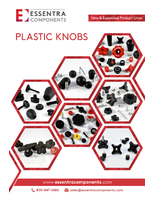SME unveils game-changing innovations.
Press Release Summary:
Outlined in SME's annual "Innovations That Could Change the Way You Manufacture list," game-changing innovations can enhance production on the factory floor. Some technologies include printed RFID tags, nanoporous silicon electrodes that double range of electric vehicles, silicon carbide electronics for harsh environments, nanotube inks that turn plain copier paper into high-energy electrodes, and polymers that heal their own scratches.
Original Press Release:
Manufacturing's Game-Changing Innovations
SME Unveils Annual "Innovations That Could Change the Way You Manufacture" List
DEARBORN, Mich., -According to recent news reports, manufacturing is showing clear signs of rebounding. Manufacturing's other good news: Eight game-changing innovations are about to enhance production on the factory floor.
Outlined in the Society of Manufacturing Engineers annual Innovations That Could Change the Way You Manufacture list, these innovations could help manufacturers save 80 percent of the cost of RFID tags, reduce the costs of producing nano fibers or even change the way electronics are designed.
SME's Innovation Watch Committee compiled the list and its members serve as "innovation researchers" who seek and publish information about technology.
"Our Committee's goal was to scan the vast technology landscape for cutting-edge innovations and to investigate ways they can be utilized," says committee member Christopher Kaye, director of innovative technology, US Endoscopy.
Here are brief outlines of each innovation:
Pay at the Store without Waiting in Line with Printed RFID Tags
Currently RFID tags can average 15 cents each. With printed RFID tags, however, manufacturers have the potential to bring these costs down by 80 percent and track products for about one to three cents a tag.
"These new printable tags are thin and flexible enough to fit on a pack of chewing gum," says committee member Terry Wohlers, president of Wohlers Associates, an independent consulting firm in rapid product development and additive manufacturing.
"This could open the door to greater consumer usage. Mobile phones with built-in RFID scanners, for example, could make it possible to pay for items without waiting in line," he says.
Double the Range of Electric Vehicles with Nanoporous Silicon Electrodes
While the demand for electric cars is growing, current lithium-ion batteries only provide a charge of up to 30 minutes. Nanoporous silicon electrodes, however, may enable these batteries to store ten times more charge.
Testing by companies like LG Chem, 3M and Sanyo is already being done and these electrodes, when matched to the right cathodes with comparable storage capacity, could help a car run for three to four hours.
Nanoporous silicon electrodes also show promise for portable electronics.
Electronics That Can Survive Harsh Environments with Silicon Carbide
With their ability to withstand extreme temperatures, SiC electronics are being used to power such things as hybrid vehicles and wind turbines, which rely on high power performance. While current technology allows for operation in up to 125 degrees Celsius or even lower at 80 degrees, SiCs have the potential to operate at up to 600 degrees Celsius.
According to Wohlers, "This new temperature capability will allow for products and design that weren't possible before."
Recycle Your Copier Paper into Batteries with Nanotube Inks
New nanotube inks can turn plain copier paper into a high-energy electrode, which can be used as economical energy storage devices. These high-energy electrodes are strong, flexible and highly conductive and might be used to power portable electronics.
Nano Fibers May Now Fit Your Budget
Often used to strengthen materials such as bikes, golf clubs, tennis rackets and drug delivery systems, nano fibers were at one time very expensive to make.
"New centrifugal force spinning machines (Forcespinning(TM)) have made mass production possible, and therefore, more cost-effective than current processes," says Wohlers.
Polymers That Heal Their Own Scratches
"Smart materials" made with self-healing agents available for elastomers, thermosets and powder coatings can be used to treat metal structures exposed to harsh environments. For the oil and gas industry, for example, these polymers could reduce costly repairs to oil rigs and pipelines.
No Need to Wait for the Engine to "Warm Up" with Phase Changing Polymers
"Smart materials" also include phase-changing polymers. PCMs are already used by BMW to store excess heat when a motor runs at operating temperature. This heat is then available at the next cold start to heat up the motor quickly and contribute to better gas mileage.
"PCM's are also being used in construction materials to help keep homes in extreme climates more temperate," says Rod Jones, Innovation Watch Committee member and chief learning officer at Mori Seiki Chicago Technical Center.
Mother Nature Inspires Manufacturing with Bio-Based Products & Materials
Mother Nature has inspired manufacturing with bio-based products and materials such as soy-foam seats.
Ford Motor Company first used soy-foam seats in the 2008 Mustang and has since placed these materials in more than 1 million vehicles leading to a reduction in carbon dioxide emissions of more than 5 million pounds.
"Bio-based products are also being used in adhesives, engine oil and carpet," says Jones.
And of the list overall, Terry Wohlers says, "These technologies are proof-positive that manufacturing is high-tech, not old-hat; not something just happening overseas. Much of manufacturing is innovation."
Innovations That Could Change the Way You Manufacture will be a central focus of the BRIDGING THE GAPS: SME Annual Conference scheduled for June 6-8, 2010 at the Sheraton Music City Hotel in Nashville, Tenn. The conference will bring together manufacturing professionals and leaders throughout North America and beyond who are interested in innovations and exchanging ideas in one place.
For the most complete information, visit www.sme.org/innovations or for more information about the SME Annual Conference visit www.sme.org/conference.
SME News Feed:
To receive the latest up-to-the-minute SME news, subscribe to RSS at http://feeds.feedburner.com/sme.
About SME:
Founded in 1932, the Society of Manufacturing Engineers is the premier source for manufacturing knowledge, education and networking.Through its many programs, events and activities, SME connects manufacturing practitioners to each other, to the latest technology and the most up-to-date processes spanning all manufacturing industries and disciplines, plus the key areas of aerospace and defense, medical device, motor vehicles, including motorsports, oil and gas and alternative energy. A 501(c)3 organization, SME has members around the world and is supported by a network of technical communities and chapters worldwide.




